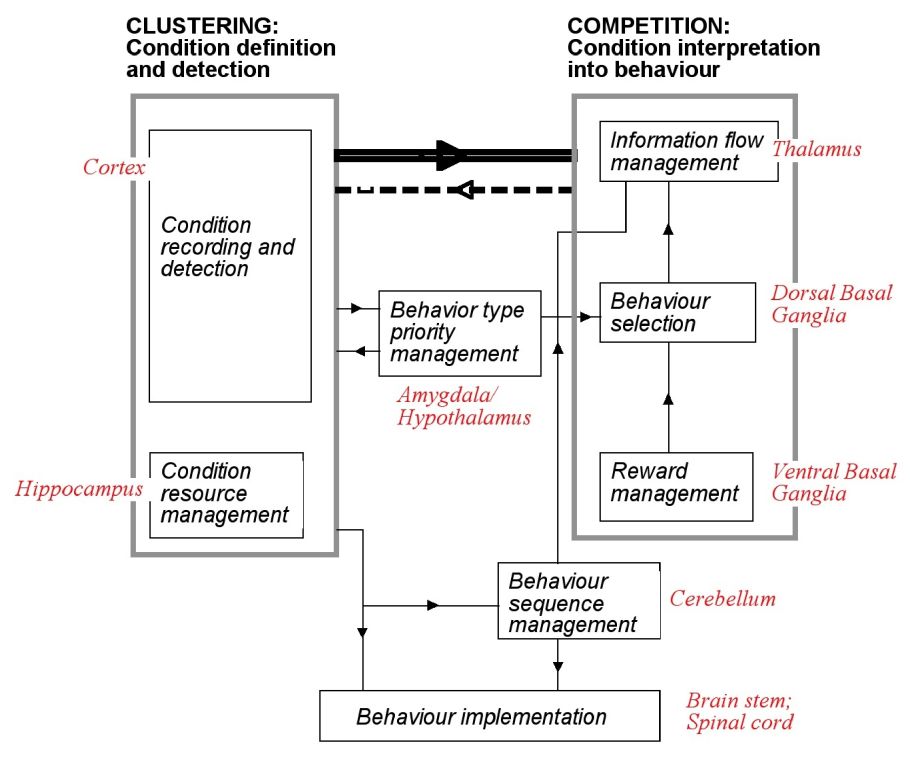 The Recommendation Architecture is the neurocognitive model for Human Cognition, developed by Leslie Andrew Coward in the Department of Computer Science, College of Engineering and Computer Science (CECS) at Australian National University (ANU), Canberra, Australia.
The Recommendation Architecture is the neurocognitive model for Human Cognition, developed by Leslie Andrew Coward in the Department of Computer Science, College of Engineering and Computer Science (CECS) at Australian National University (ANU), Canberra, Australia.
Email: Этот адрес электронной почты защищён от спам-ботов. У вас должен быть включен JavaScript для просмотра. | Andrew Coward's Homepage
Когнитивная архитектура Recommendation Architecture разрабатывалась под руководством Эндрю Коварда (Leslie Andrew Coward) в Колледже вычислительной техники (Department of Computer Science, College of Engineering and Computer Science) Австралийского национального университета (Australian National University), расположенного в Канберре, Австралия.
Общие сведения
Abstract
A model for human cognitive processing is described. The advantages of the model are that it is able to learn complex combinations of capabilities with limited information recording and processing resources; it can bootstrap its memory and cognitive capabilities from experience with very limited, genetically plausible a priori guidance; and modules in the model resemble physiological structures in the brain.
In the model, all information recorded or activated in the cortex is perceptually, cognitively and behaviourally ambiguous.
Cognitively complex processing occurs within populations of ambiguous information, and only achieves unambiguous meanings in subcortical structures. The model can account for a wide range of cognitive phenomena with a limited range of information recording and access mechanisms, as illustrated by a detailed discussion of working memory phenomena.
However, the need to limit resources means that modules in the model are defined as collections of similar system operations and do not correspond with cognitive features or categories.
Descriptions of cognitive phenomena are therefore more complex than "user manual" type models, but "user manual" type models are not capable of providing an understanding of these phenomena in terms of physiology.
An electronic implementation of the model confirms its viability.

Knowledge and experiences are represented using: A large set of heuristically defined similarity circumstances, each of which is a group of information conditions that are similar and have tended to occur at the same time in past experience. One similarity circumstance does not correlate unambiguously with any one cognitive category, but each similarity circumstance is associated with a range of recommendation weights in favour of different behaviours (such as identifying categories in current experience). The predominant weight across all currently detected similarity circumstances is the accepted behaviour
Main components:
Condition definition and detection (cortex);
Selection of similarity circumstances to be changed in each experience (hippocampus);
Selection of sensory and other information to be used for current similarity circumstance detection (thalamus);
Assignment and comparison of recommendation weights to determine current behaviour (basal ganglia);
Reward management to change recommendation weights (nucleus accumbens etc.);
Management of relative priority of different types of behaviour (amygdala and hypothalamus);
Recording and implementation of frequently required behaviour sequences (cerebellum)
Implementation: Smalltalk
Main general paradigms: All cognitive processes are implemented through sequences of receptive field activations, including both direct detections and indirect activations. At each point in the sequence the behaviour with the predominant recommendation weight across the currently activated receptive field population is performed.
This behaviour may be to focus attention on a particular subset of current sensory inputs or to implement a particular type of indirect activation (prolong current activity, or indirectly activate on the basis of recent simultaneous activity, past frequent simultaneous activity, or past simultaneous receptive field change).
Recommendation weights are acquired through rewards that result in effective sequences for cognitive processing. Frequently used sequences are recorded in the cerebellum for rapid and accurate implementation.
Publications
The theoretical considerations and descriptions of how higher cognition can be understood in terms of physiology are presented in published papers and also in the book "A System Architecture Approach to the Brain: from Neurons to Consciousness" recently released in paperback.
1. Coward, L. A. (1990). Pattern Thinking, New York: Praeger.
2. Andrew Coward. A Systems Architecture Approach to the Brain: From Neurons to Consciousness. Seminar, 2006 (Abstract and Video of Seminar)



